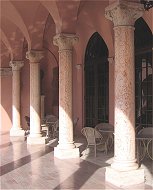Travertine ColumnsDescription: The 4 travertine columns, just behind the Museum's doors, might be 17th century. All other columns in the courtyard are cast in the 20th century. They are of different length. Each pedestal underneath each column was tailormade to fit each column. Source: David Weeks in docent training class, January 18, 2000 |
Travertine:
The rock travertine is a natural chemical precipitate of carbonate minerals; typically
aragonite, but often recrystallized to or primarily calcite; which is deposited from the
water of mineral springs (especially hot springs) or streams saturated with calcium
carbonate. When pure, travertine is white, but often is brown to yellow due to impurities.
When carbon dioxide-rich water percolates through rocks in limestone areas, the water
dissolves the limestone and becomes saturated with it. When the water resurfaces later,
the sudden drop in pressure and the change in temperature cause the water to release the
carbon dioxide gas, much like fizzy drinks. The calcium carbonate then recrystallizes,
often over minute underwater plants. The resulting rock is typically quite porous with
numerous cavities. When exceptionally porous it is known as calcarious tufa.
Extensive deposits exist at Tivoli, Italy, near Rome. In fact, travertine derives its name
from this town. Tivoli was known as Tibur in ancient Roman times. The ancient name for the
stone was lapis tiburtinus meaning tibur stone, which has been corrupted to travertine.
Detailed studies of the Tivoli travertine deposits revealed diurnal and annual rhythmic
banding and laminae which have potential use in geochronology (Folk, 1985).
Travertine has formed 16 huge, natural dams in a valley in Croatia known as Plitvice
National Park. The Travertine clings to moss and rocks in the water, and has built up over
several millennia to form waterfalls up to 70 m in height. More info can be found at the
park's website and Plitvice.
Other beautiful cascades of natural lakes formed behind travertine dams can be seen in
Band-i-Amir (Afghanistan), HuangLong Valley (Sichuan, China), Semuc Champey (Guatemala),
and Pamukkale (Turkey). Many geyser fields also have colorful travertine deposits.
The largest building in the world constructed largely of travertine is the Colosseum in
Rome. Other notable buildings using travertine extensively include the Sacr -Cœur
Basilica in Paris and the Getty Center in Los Angeles, California. The travertine used in
the construction was imported from Tivoli. The website of the Getty Center contains more
information about the use of travertine in its construction, including some videos of
travertine being quarried and cut for use. The stone is most widely used in Italy, Greece
and Turkey.
Travertine is one of several natural stones that are used for paving patios and garden
paths. It is sometimes known as travertine limestone, sometimes as travertine marble;
these are the same stone, even though it is neither limestone nor marble. The stone is
characterised by pitted holes and troughs in its surface. Although these troughs occur
naturally, they suggest to some eyes that considerable wear and tear has occurred over
many years. Some installers use a grout to fill these holes, whereas others leave them
open — travertine can even be purchased "filled" or "unfilled."
It can be effectively polished to a smooth, shiny finish and comes in a variety of colors
from grey to coral-red. Travertine is most commonly available in tile sizes for floor
installations.
Travertine is one of the most frequently used stones in modern architecture, and is
commonly seen as facade material, wall cladding, and flooring. Architect Welton Becket was
one of the most frequent users of travertine, incorporating it extensively into many if
not most of his projects. The entire first floor of the Becket-designed UCLA Medical
Center has thick travertine walls.
